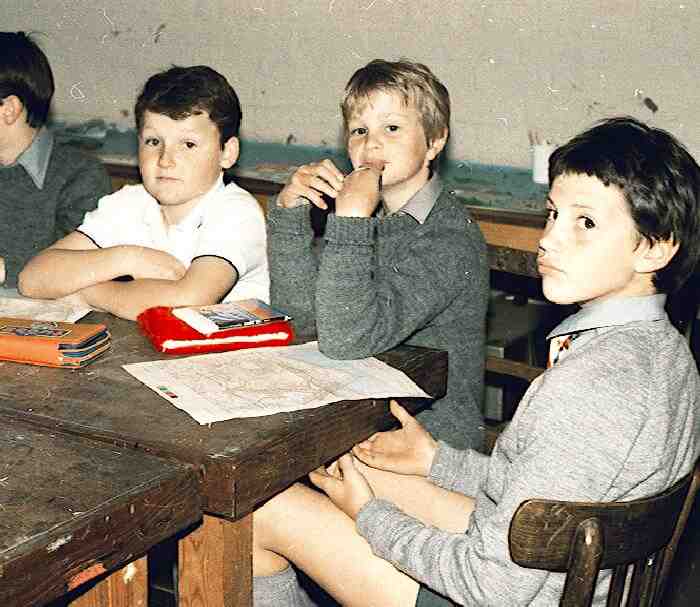
English School Jumpears and Sweaters: Chronology

Figure 1.--The standard grey school sweater without colored trim in the 1980s was widely worn throughout England in the 1980s. Schools often did not insist on the exact shade of grey as long as the sweater was grey. For more information on prep schools, click on the image. Apertures Press has both a published book and an E-book on prep schools.
|
HBC at this time has relatively little chronological information and can only speculate about trends. HBC would be interested in any details English readers can add. The most popular style has been the "V" nuck sweater because so many schools insisted the children wear ties. We have noticed cardigans and crew-neck sweaters being worn, but by the 1950s, the grey "V" neck sweater was the standard style. Mums and grandmothers were still knitting sweaters, but more and more boys were wearing stote-bought, often play grey sweaters. Some Girls in the 1950s still wore Cardigan sweaters rather than blazers. An English reader in secondary school during the 1970s tell us, "When I first went to secondary school the only jumpers allowed were grey ones with the school colours on them. Sweaters continue to be one of the most used school uniform garments. They were the normal classroom wear except during when the weather turns warm during the summer term. Grey continued to be the most common color. Boys had worn mostly wool sweaters, but in the 1980s some schools began adopting jumpers made with synthetic fibers, primarily because of the lower cost. Some schools in the 1990s began replacing jumpers with sweatshirts. They were less expensive and could be ordered with school logos.
1950s
Mums and grandmothers were still knitting sweaters, but more and more boys were wearing stote-bought, often play grey sweaters. Some Girls in the 1950s still wore Cardigan sweaters rather than blazers. They did not wear jumpers, but did wear blazers at many schools. Many schools began relacking rules requiring boys to wear their blazers uring the school day and it became increasingly common for boys to wear just their sweaters during the school day. Many schools in the 1960s began adopting jumpers with color detailing at the collar, wrist cuffs, or waist band. Some also had the school leaders or symbol. The plain grey, sweater, however, was still the most common.
1960s
Many schools began relacking rules requiring boys to wear their blazers uring the school day and it became increasingly common for boys to wear just their sweaters during the school day. Many schools in the 1960s began adopting jumpers with color detailing at the collar, wrist cuffs, or waist band. Some also had the school leaders or symbol. An English reader in primary school during the 1960s-70s tell us, "Gerally jumpers were not compulsory as far as I remember. There were different rules – for instance at my COE primary school boys could wear jumpers if they wanted – they had to be grey. Girls always wore cardigans and these were navy blue. Our jumpers were plain – short or long-sleeved but always v-necked as we wore ties. Some were hand-knitted – later (around the late 60s) they were shop-bought. My mate Michael's school had their school colours on their jumpers like on their socks – I think this was unusual for a state primary school in London but his school was considered one of the best R.C. Primary schools in the area and were a sort of rival to my C. of E. school – which also had a reputation but weren't so strict as far as uniform went then. For instance we'd done away with caps when I was about 8 – 1967 – but his still wore them." This reader remembers an experience with his favorite jumper concerning a field trip.
1970s
An English reader in secondary school during the 1970s tell us, "When I first went to secondary school the only jumpers allowed were grey ones with the school colours on them. I'm wearing mine in my secondary school photo. By the time I'd been there a couple of years they were letting boys get away with wearing plain jumpers – as long as they were v-necked and some shade of grey – when I was 15 I had a black one."
1980s
Sweaters continue to be one of the most used school uniform garments. They were the normal classroom wear except during when the weather turns warm during the summer term. Grey continued to be the most common color. Boys had worn mostly wool sweaters, but in the 1980s some schools began adopting jumpers made with synthetic fibers, primarily because of the lower cost. It was rare by the 1980s to see boys wearing hand-knitted sweaters to school.
1990s
Some schools in the 1990s began replacing jumpers with sweatshirts. They were less expensive and could be ordered with school logos. Unlike "V"-neck sweaters sweaters they were not made to be worn with ties.
HBC-SU

Navigate the Boys' Historical Clothing School Uniform Pages
[Main English School Uniform Jumper Page]
[Australia]
[England]
[France]
[Germany]
[Italy]
[Japan]
[New Zealand]
[Scotland]
[Singapore]
[South Africa]
[United States]
Navigate the Boys' Historical Clothing Web Site:
[Introduction]
[Activities]
[Biographies]
[Chronology]
[Clothing styles]
[Countries]
[Bibliographies]
[Contributions]
[FAQs]
[Glossary]
[Satellite sites]
[Tools]
[Boys' Clothing Home]
Created: 6:49 AM 8/23/20044
Last updated: 6:49 AM 8/23/2004




